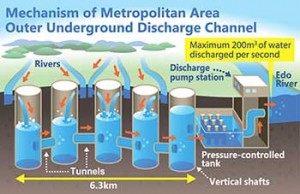http://www.theclimategroup.org/what-we-do/news-and-blogs/japan-will-soon-have-the-worlds-largest-floating-solar-power-plant/
The article describes Japan’s undertaking of another project to provide for the country’s energy needs – by constructing floating solar plants. Set to be constructed in the Hyogo Prefecture, the plants are expected to be completed around March next year.
To construct what is being touted as “the world’s largest floating solar power plant” in the span of a few months is no small feat. The speed at which such measures to adopt ‘green’ forms of energy are being carried out is a testament to the aftereffects of the Fukushima Daiichi nuclear disaster. Previously, around 30% of Japan’s electrical power had been generated by nuclear reactors (World-nuclear.org, 2014). Now with future nuclear projects now on indefinite hold, there exists an increasing need to seek an alternative source of stable energy production.
Japan has begun to adopt green energy as a means to fill that vacuum, and this project is one such means of harnessing that energy for use. Residents have noted that their living environments are being transformed by the construction of solar panels in residential spaces, even appearing near rivers and replacing rice paddies (Tofugu.com, 2014).
However, it is also important to examine the nature of Japan’s solar revolution and its impact on the environment. Referring to the article, by constructing a plant on a lake, there are already implications that the project intrudes into the lake’s ecology. As such, the plant’s efficiency should not be the sole focal point, as it also has to be examined vis-a-vis its surrounding environment. The article mentions how the plant’s structure would enable the water of the lake to provide cooling for the plant. By doing so, the plant is claimed to be able to generate less heat, making efficiency of operations “superior by 11%”.
Yet less heat does not equate to no heat being generated by the operations of the solar plant. There is no mention of what happens to the lakewater after it has been used for cooling the plant’s solar photovoltaic (PV) modules. Should the heated water be pumped back into the lake, the lake’s ecology and marine life would be affected by such changes in the water’s temperature. The article makes no effort to address such possible concerns, instead choosing to emphasize the attractiveness of having an efficient source of energy via graphs, claiming that “evidence that barriers to clean technology can be overcome”.
Solar panels have thus increasingly found their way into natural spaces. As mentioned above, solar panels have also been installed by riversides and mountains. Besides the transformation of urban areas, the natural environment is also being shaped by the drive towards a ‘green’ sustainable form of energy. Solar energy plants are able to promise a steady supply of energy without greenhouse gas emission and without the same degree of risk as nuclear energy. Yet at the same time, can it truly be ‘green’ if it involves the replacement of nature with something artificial, or if the pursuit of solar energy results in negative consequences for the environment?
I realize that this is not a question easily answered, nor will such a debate come to a concrete conclusion as sustainable forms of energy come with their respective advantages and disadvantages. While Japan appears to have taken increasing measures towards pursuing solar power, going as far as to invent sun-chasing solar panels (Solardaily.com, 2014), it remains to be seen how much of a balance can be struck between the natural environment and such man-made inventions.
References:
Solardaily.com,. (2014). Japan firm develops ‘sun-chasing’ solar panels. Retrieved 28 September 2014, from http://www.solardaily.com/reports/Japan_firm_develops_sun-chasing_solar_panels_999.html
Tofugu.com,. (2014). Japan’s Solar Revolution – The Sky’s (Not) the Limit. Retrieved 28 September 2014, from http://www.tofugu.com/2014/05/29/japans-solar-revolution-the-skys-not-the-limit/
World-nuclear.org,. (2014). Nuclear Power in Japan – Japanese Nuclear Energy. Retrieved 28 September 2014, from http://www.world-nuclear.org/info/Country-Profiles/Countries-G-N/Japan/


